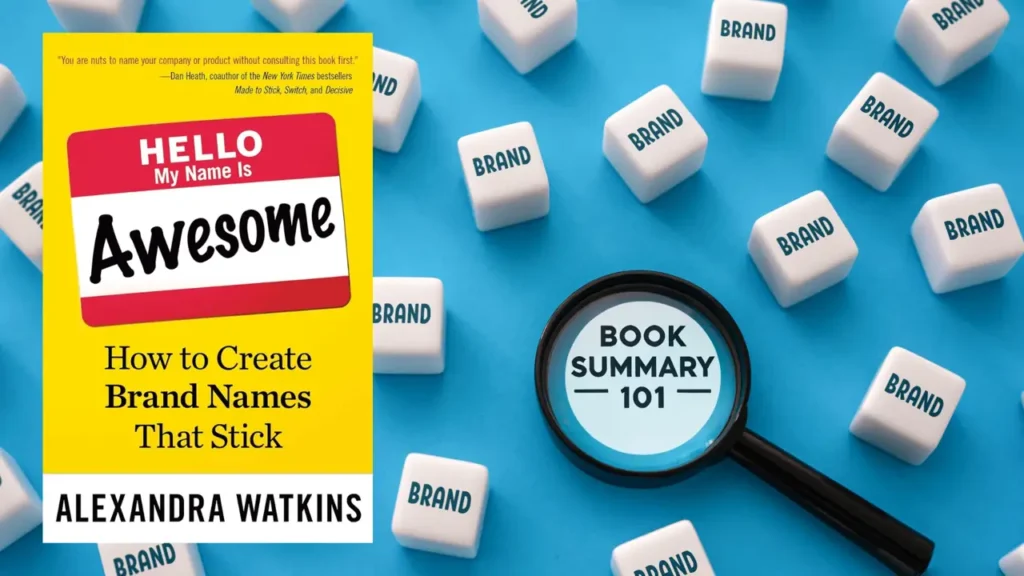If you’ve ever agonized over naming your brand, business, or product, Alexandra Watkins’ book Hello, My Name is Awesome: How to Create Brand Names That Stick might just be the friendly (and super helpful) guide you’ve been looking for. This isn’t your typical branding book full of corporate jargon and boring theory. Instead, Watkins cuts to the chase with a fun, witty approach that simplifies the process, helping you understand not only how to name something but also how to make that name unforgettable.
The book on amazon 👉 Hello my name is awesome 📚
Why Read This Book?
The truth is, we all know a good name when we hear one. But creating a name that’s catchy, easy to remember, and meaningful? Not as simple as it sounds. Watkins knows this struggle and has come up with her “SMILE & SCRATCH” Test, a framework to decide if your brand name will resonate with people or fall flat. Hello, My Name is Awesome is a must-read for entrepreneurs, marketers, and even writers, especially if you’re looking to build a brand identity that sticks in people’s minds.
With tips that make naming feel less intimidating and examples that make it engaging, Watkins shows us the impact of a great name—and the downsides of a bad one. And the best part? You don’t have to be a branding expert to make this advice work for you.
That Make You Go “Aha!”: SMILE & SCRATCH in Action
What makes Hello, My Name is Awesome stand out is how Watkins makes her naming philosophy come to life with real examples. Her SMILE & SCRATCH Test isn’t just theory; it’s a practical tool for checking if your brand name has that “sticky” quality people remember. Let’s break it down in more detail, with examples to show how each element of SMILE can elevate a name and each SCRATCH factor can drag it down.
SMILE: The 5 Keys to a Great Brand Name
S – Suggestive: Great names hint at something meaningful about the brand. They go beyond a literal description to give you a taste of the experience or emotion the brand promises. Watkins loves the name Amazon, which suggests something vast and expansive—a fitting name for what became the world’s largest online marketplace. Another example? SoulCycle. This name hints at a deep, transformative experience, rather than simply “indoor cycling.” It suggests that the workout is as much about inner growth as it is about fitness. That’s the power of a suggestive name—it taps into emotions and makes people feel connected even before they try the product.
M – Meaningful: Watkins stresses that a name has to mean something specific to your target audience. Airbnb, for example, isn’t just a random name. It’s a blend of “air mattress” (from its scrappy early days) and “bed and breakfast,” evoking the idea of an affordable, homey place to stay. It connects immediately with people looking for unique, affordable travel experiences. Meaningful names cut through the noise, making it clear what the brand stands for right from the start.
I – Imagery: Memorable names create vivid images that stick in the mind. Think of Red Bull. This name immediately brings to mind the image of a powerful, unstoppable bull—exactly the energy boost the drink promises. Another favorite of Watkins is Lush, a beauty brand name that conjures images of abundance, freshness, and natural indulgence. These names are more than words—they’re pictures, and those pictures stay with you.
L – Legs: A name with “legs” has room to grow. It can expand into new areas, products, or markets without losing its relevance. Watkins cites Uber as a great example. The name, which means “superior” or “ultimate,” isn’t restricted to ridesharing; it has expanded to Uber Eats and Uber Freight, among other services. A name with legs can evolve, ensuring your brand stays relevant even as you branch out.
E – Emotional: The best names make you feel something, even if it’s just a hint of curiosity or excitement. Tesla, for instance, brings to mind innovation and daring, thanks to its association with the inventor Nikola Tesla. Emotional names create connections that go beyond logic. They reach people’s hearts and stick because they feel authentic. Watkins encourages using names that make people feel happy, excited, or even just intrigued.
Watkins goes on to call out bad names with her signature humor—like an actual accounting firm named Boring & Dull (yep, that’s real). Through these examples, you can see why some names shine while others fade into obscurity.
SCRATCH: The 7 Deadly Sins of Naming
While SMILE highlights what makes a name strong, SCRATCH is the list of common pitfalls that make names forgettable or, worse, off-putting. Here’s a closer look at what Watkins warns against.
S – Spelling-Challenged: Names that are hard to spell or pronounce are easily forgotten. Watkins calls out brands like Flickr or Lyft that misspell common words, creating confusion. Though some spelling-challenged names do succeed, Watkins advises caution: if people can’t spell or pronounce it, they probably won’t remember it or tell others about it easily.
C – Copycat: Copycat names are everywhere, especially in competitive markets. Watkins points out how many new tech companies adopt names with the “-ly” suffix (Grammarly, Barkly, Medly), hoping to mimic successful brands like Spotify. But sounding like everyone else makes it hard to stand out. In a crowded field, a unique name can make all the difference.
R – Restrictive: A restrictive name boxes your brand into a narrow category, making it hard to grow beyond that initial idea. Imagine if Amazon had started as “BooksOnline”—not very flexible for a company that would go on to sell everything. Another example is RadioShack, a name that limited the brand to a certain image and product range. Watkins advises against names that lock you into a specific product or market, especially if you hope to expand in the future.
A – Annoying: Watkins points out names that are awkward, overly clever, or hard to remember. She suggests avoiding puns or forced alliteration, which can come across as gimmicky. Brands like Yahoo! may be fun, but quirky names aren’t always a plus if they turn off your audience. Striking a balance between creativity and clarity is essential.
T – Tame: Tame names are forgettable because they lack personality or punch. Watkins calls out generic names like General Electric, which describe what the brand does but don’t spark any interest. Brands like Nike, with a bold, iconic name, do much better. A tame name may not offend anyone, but it won’t excite or intrigue anyone either.
C – Curse of Knowledge: This happens when names are too technical or insider for the average person. Watkins warns against names that only make sense to people in the industry. For instance, using a scientific term as a brand name might resonate with experts but leave everyday consumers scratching their heads.
H – Hard-to-Pronounce: If people struggle to say your name out loud, it’s a major obstacle. Watkins recalls when Volkswagen launched the “Touareg” SUV in the U.S.—a name that many Americans found impossible to pronounce. Complex names may work in specific cultures or regions, but when aiming for wide appeal, simplicity is key.
With SMILE and SCRATCH, Watkins offers a naming guide that’s practical, memorable, and even a little funny. These frameworks, paired with her engaging examples, make Hello, My Name is Awesome both an entertaining read and a toolkit for any business owner, marketer, or creative trying to name a brand that sticks.
The Final Point
Whether you’re brainstorming a new brand name or just have an interest in what makes certain brands memorable, Hello, My Name is Awesome is a quick, insightful read that doesn’t waste your time with filler. It’s practical and gets straight to the point—perfect for anyone who’s ever wondered why people remember brands like Amazon or Starbucks but forget others instantly. Watkins even throws in a “Creative Brief” at the end to help you test out your new ideas.
So, what are your favorite brand names? Have you had any naming nightmares? Let’s chat in the comments—maybe we’ll even come up with some awesome names together!
The book on amazon 👉 Hello my name is awesome 📚


